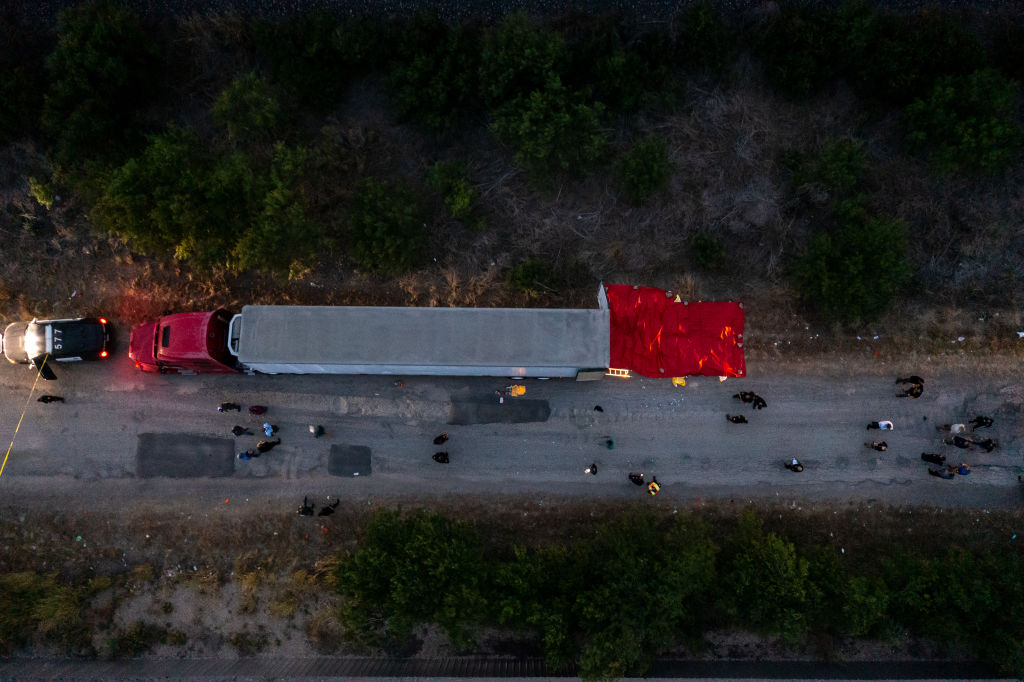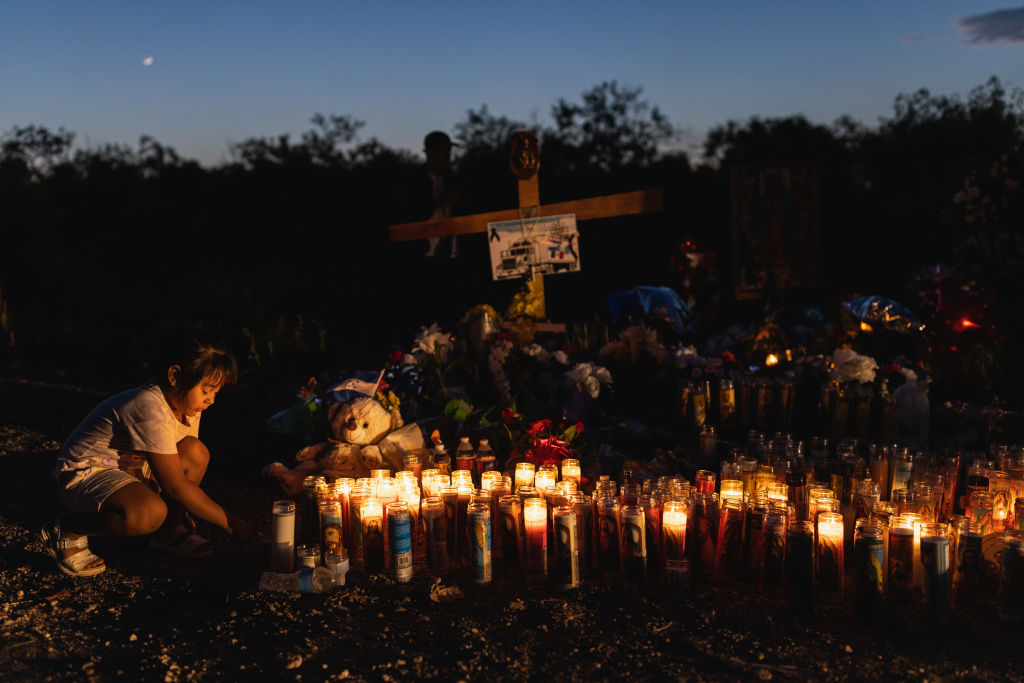
Four men are in jail charged in connection to the failed human smuggling attempt that left 53 people dead in San Antonio in June, but experts and advocates who have studied migrant death tolls say that won’t stop similar tragedies from happening again. The event in San Antonio was the result of rigid deterrence policy at the United States-Mexico border, they argue, which fuels the dangerous human smuggling trade.
As the U.S. utilizes strict border policies that restrict legal pathways to the U.S.—such as preventing asylum-seeking through the COVID-19 health measure known as Title 42, and limiting pathways to temporary work visas—the demand and cost for human smugglers increases, researchers say.
The mix of hardline U.S.-Mexico border policy, dangerous geography, the rising number of people migrating north to the U.S. in recent years, and their increasing vulnerability and desperation, sustain what some experts describe as sophisticated human smuggling operations that increasingly involve organized crime groups. While individual perpetrators like those in San Antonio may be held to account, the underlying factors driving migrants to smugglers haven’t been addressed. “Simply doing border enforcement, particularly under Title 42,” without increasing access to legal pathways to the U.S., “is just increasing the incentives for things like this kind of smuggling to take place,” says Doris Meissner, senior fellow and director of the U.S. Immigration Policy Program at the Migration Policy Institute (MPI), a nonpartisan research organization.
Despite the danger, some people in desperate situations still opt for a smuggler’s services rather than wait in limbo in Mexico for a legal pathway into the U.S., says Jason De León, executive director of the Colibrí Center for Human Rights and the Undocumented Migration Project, two Arizona organizations that work together to identify the bodies of migrants found dead in the Arizona desert. “Most people are not forced into getting into the back of those [semi-]trucks,” says De León, who is also a professor of anthropology at UCLA and who is working on a book about human smuggling from Honduras to the U.S.-Mexico border. “They know it’s a risky thing to do, but they’re hoping that it will be successful…I can promise you that there are semi-trucks in South Texas right now that have migrants in the back of them that are crossing through checkpoints because people are so desperate, and the smugglers are just trying to find ways to provide these clients with services.”
Since the United Nations’ International Organization for Migration (IOM) began collecting data in 2014, it has documented nearly 3,000 migrant deaths at the U.S.-Mexico border—but many experts believe the real number is significantly higher. In 2021, 728 migrant deaths and disappearances were recorded at the U.S.-Mexico border, according to the IOM, 53% more than in 2020.
After tragedies like San Antonio, researchers say U.S. officials must take into account how American border policy influences migrants’ willingness to turn to smugglers—particularly under Title 42. The health measure that the U.S. Centers for Disease Control and Prevention invoked in March 2020 has been used by border officials to immediately expel people who cross the U.S.-Mexico border, even if they wish to claim asylum, in the name of mitigating the spread of COVID-19. Since the measure began, border officials have conducted more than 2 million expulsions under Title 42 at the U.S.-Mexico border, according to U.S. Customs and Border Protection (CBP).
After being expelled, many of those people are incentivized to turn to smugglers, Meissner says. What happened in San Antonio is an “extreme example of what really needs to be more fully understood about the border,” she says. “We can’t enforce our way out of this issue of migration pressures and migration flows.”

Smuggling 64 people through Texas
On June 27, 45-year-old Homero Zamorano Jr. was arrested after attempting to flee the scene of the crime near Quintana Road in southwestern San Antonio. When San Antonio law enforcement and immigration officials arrived at the scene, 48 migrants were already dead, some of their bodies “stacked” inside the back of the semi-truck, hot to the touch, according to San Antonio Fire Chief Charles Hood, who spoke to reporters on June 27. The survivors were taken to nearby hospitals, but five more would later die.
Zamorano allegedly transported a total of 64 migrants—mostly from Mexico, some from Guatemala and Honduras—in the back of the semi-truck without a working air conditioning unit. He is charged with the transportation of undocumented immigrants resulting in death and faces life in prison. Christian Martinez, 28, who Zamorano was allegedly communicating with during the smuggling operation, has also been arrested and faces similar charges, and two other men, who allegedly have ties to the semi-truck used in the smuggling, have also been arrested and detained without bond.
Smugglers do their work in every region of Central America and Mexico, and well past the U.S.-Mexico border. The routes used by smugglers include journeys into dangerous terrain to circumvent U.S. border enforcement officials and checkpoints. Other operations, including what took place in Texas on June 27, can include hiding migrants in vehicles, according to a 2020 study by the University of Texas at Austin’s Strauss Center for International Security and Law. Crossing into Texas with or without smugglers, migrants risk dehydration, drowning, exposure to the elements, motor vehicle accidents, and violence, according to the Strauss Center study.
In the week prior to the June 27 tragedy, Border Patrol’s Laredo Sector apprehended over 400 undocumented immigrants who were being smuggled in commercial vehicles in six separate smuggling operations, the agency said on its Facebook page—an observation first publicized by Gabriella Sanchez, a socio-cultural anthropologist and director of field research at the University of Massachusetts Lowell. “As long as people are not given equal access to visas and passports,” she says, “it doesn’t matter how many billions governments spend. Fueling that demand is that very lack of the ability to move safely, legally.”
The smuggling industry is evolving, and there is much still unknown about smuggling operations throughout Central America, Mexico, and into the U.S. Sanchez argues smugglers are often members of migrant communities themselves. “When you actually go and spend time in these communities… you’re going to see that this is a crime of the poor for the poor,” she says. De León, on the other hand, argues smuggling is increasingly controlled and operated by organized crime—a position also held by the U.S. federal government and other migration scholars. (Investigators have not shared whether Zamorano, Martinez, or the other two men arrested after the June 27 tragedy are connected to organized crime groups.)
Paying a smuggler or the organized crime groups that control Mexican territory can cost anywhere from $2,000 to $7,000, according to De León. To cross the U.S.-Mexico border will cost an additional $3,000 to $5,000. “Organized crime is trying to put its hand into every aspect of the process,” De León says. “It doesn’t matter if you are moving sort of piecemeal or with different smugglers, or without a smuggler, across the length of Mexico. No matter what, you’re still having to interact with organized crime in terms of paying head taxes to get through different regions.”
‘They’re still coming’
After the tragedy in San Antonio, the White House stressed the need to bring down the “criminal smuggling industry.”
“Exploiting vulnerable individuals for profit is shameful, as is political grandstanding around tragedy, and my Administration will continue to do everything possible to stop human smugglers and traffickers from taking advantage of people who are seeking to enter the United States between ports of entry,” President Joe Biden said in a public statement on June 28.
According to the White House, an “anti-smuggling campaign” in partnership with other nations, led to more than 2,400 arrests in the first three months since its launch. The White House did not immediately return TIME’s request for further details about who has been arrested and what charges they face.
Read More: Biden Administration Cheers New International Migration Agreement. Experts Say It May Not Do Much
Texas Governor Greg Abbott, a Republican, blamed Biden for the deaths in San Antonio. “These deaths are on Biden,” Abbott said on Twitter on June 27. “They are a result of his deadly open border policies. They show the deadly consequences of his refusal to enforce the law.”
Yet many experts argue that deterrence measures are what contributed to the San Antonio tragedy— policies that have hardened the border rather than relaxed it. Since the 1990s, the U.S. has relied on strict border enforcement policies that are intended to dissuade people from making illegal crossings. Some of these policies make the migration journey more dangerous. When immigration officials decided to concentrate resources at urban areas along the border and ports of entry, for example, those who intended to circumvent the legal process would then have to cross into hazardous terrain, leading to deaths and increased reliance on human smugglers. Recent policies like Title 42, Migrant Protection Protocols (MPP), which requires asylum-seekers to wait in Mexico while their asylum case is adjudicated, and some of the Trump-era “zero tolerance” policies that included family separation, are considered such deterrence measures by experts. The Biden Administration has continued to enforce Title 42 expulsions and MPP. (A federal court said the Biden Administration cannot end Title 42, a decision the government is appealing, but the Supreme Court recently said it could unwind MPP.)
“[The U.S.] is hoping that if enough of those folks die, that they will be dutiful, will be deterred from coming,” De León says. “But clearly that has not been the case. Thousands of people have died. Migrants know full well about the dangers, and yet they’re still coming, still willing to go into the desert, they’re still willing to get in the back of a semi-truck, which just means that the things that they are running from are so much worse.”
More Must-Reads from TIME
- Where Trump 2.0 Will Differ From 1.0
- How Elon Musk Became a Kingmaker
- The Power—And Limits—of Peer Support
- The 100 Must-Read Books of 2024
- Column: If Optimism Feels Ridiculous Now, Try Hope
- The Future of Climate Action Is Trade Policy
- FX’s Say Nothing Is the Must-Watch Political Thriller of 2024
- Merle Bombardieri Is Helping People Make the Baby Decision
Write to Jasmine Aguilera at jasmine.aguilera@time.com